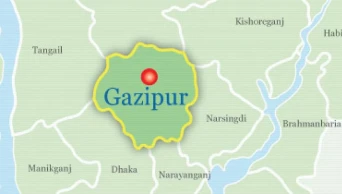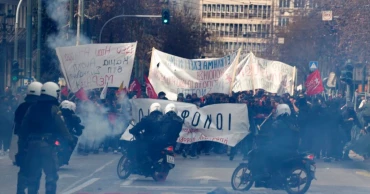Train crash
Train crushes a man and a boy to death in Gazipur
Two people were killed after being run over by a speeding train in Gazipur's Tongi on Monday night.
Their identities could not be known yet but it is suspected that they were father and son, police said quoting locals on Tuesday.
Mother with 8-month-old infant jumps in front of train in Gazipur; both dead
According to Sub-Inspector Choton Sharma of Tongi Railway Police Outpost, the incident occurred around 10:30 pm near the Bonmala area on the Dhaka-Mymensingh rail route. A Kurigram Express train struck the victims, killing them on the spot.
Efforts are on to identify them, he said.
Three killed, seven Injured in separate road accidents in Faridpur
Police recovered the bodies and sent them to the morgue for autopsy, he added.
1 year ago
Train crash in Egypt kills 1 and injures more than 20 people
A locomotive crashed into the tail of the Cairo-bound passenger train Sunday in southern Egypt, killing at least one person and injuring multiple others, authorities said. It is the second train crash in a month in the North African country.The collision occurred in the province of Minya, 270 kilometers (about 168 miles) south of Cairo, the railway authority said in a statement, and two railway carriages fell into an adjacent watercourse. The cause of the crash was being investigated, the statement added.
Footage aired by local media showed the two carriages partially submerged in the watercourse.
Apparent Israeli airstrike on mosque in central Gaza kills at least 18 people
Along with the fatality, the Health Ministry said in a separate statement at least 21 people were taken to hospitals, of which 19 were later discharged after receiving treatment.
Train derailments and crashes are common in Egypt, where an aging railway system has also been plagued by mismanagement. In September, two passenger trains collided in a Nile Delta city, killing at least three people.
In recent years, the government announced initiatives to improve its railways. President Abdel Fattah el-Sissi said in 2018 some 250 billion Egyptian pounds, or $8.13 billion, would be needed to properly overhaul the neglected rail network.
1 year ago
Indian authorities arrest 3 railway officials over the train crash that killed more than 290 people
India’s federal crime agency said Friday (July 07, 2023) it has arrested three railway officials in connection with one of the country’s deadliest train accidents, which killed more than 290 people last month.
The arrested men have been charged with culpable homicide without murder and destruction of evidence, the Central Bureau of Investigation said in a statement. It identified them as two signal engineers and one technician, and said the investigation is ongoing.
Error in signaling system led to train crash that killed 275 people in India, official says
June’s train crash in eastern Odisha state occurred when a packed passenger train was mistakenly diverted onto an adjacent loop line where it rammed into a stationary freight train loaded with iron ore. The collision derailed the passenger train’s coaches onto another track where they struck a passing train that was running in the opposite direction.
The two passenger trains were carrying more than 2,290 people when the collision took place. Nearly 1,000 people were injured.
India’s deadly train crash renews questions over safety as government pushes railway upgrade
After the accident, India’s Railway Minister Ashwini Vaishnaw said the cause of the crash was related to the signaling system.
India, a country of 1.42 billion people, has one of the world’s most extensive and complicated railways built during the British colonial era: more than 40,000 miles (64,000 kilometers) of tracks, 14,000 passenger trains and 8,000 stations. Spread across the country from the Himalayas in the north to the beaches in the south, it is also a system that is weakened by decades of mismanagement and neglect.
Despite efforts to improve safety, several hundred accidents happen every year, and most such crashes are blamed on human error or outdated signaling equipment.
Indian officials end rescue work for 2 wrecked passenger trains that killed over 300 people
The June crash was India’s deadliest since 1995, when two trains collided near New Delhi, killing 358 people. In 2016, a passenger train slid off the tracks between the cities of Indore and Patna, killing 146 people.
2 years ago
‘I am haunted by it’: Survivors of deadly train crash in India recount trauma
Gura Pallay was watching another train pass by the one he was sitting in when he heard sudden, loud screeching. Before he could make sense of what was happening, he was thrown out of the train.
Pallay, 24, landed next to the tracks along with metal wreckage of the train he’d been riding in, and instantly lost consciousness. The first thing he saw when he opened his eyes was the twisted remains of three trains on the tracks.
His train had derailed after colliding with a stopped freight train. Another passenger train, the one he had seen pass by moments earlier, had hit the derailed carriages.
“I saw it with my own eyes, but I still can’t describe what I saw. I am haunted by it,” he said Sunday at a hospital, where he lay on a stretcher with a broken leg and dark wounds on his face and arms.
Pallay is a laborer, like most of the people onboard the two passenger trains that crashed Friday in the eastern Odisha state, killing 275 people and injuring hundreds. He was traveling to Chennai city in southern India to take up a job in a paper mill factory when the Coromandel Express crashed with a goods freight train, knocking it off track, and was then hit by a second train coming from the opposite direction on a parallel track.
Read: Error in signaling system led to train crash that killed 275 people in India, official says
“I never imagined something like this could happen, but I guess it was our fate,” he said.
Investigators said Sunday that a signaling failure might have caused the three-train crash, one of the worst rail disasters in the country’s history. Authorities recommended that India’s Central Bureau of Investigations, which probes major criminal cases, open an investigation into the crash.
“We can’t bring back those we have lost, but the government is with the families in their grief. Whosoever is found guilty will be punished severely,” Prime Minister Narendra Modi said Saturday while visiting the site of the accident.
The crash occurred as Modi’s government is focusing on the modernization of India’s British colonial-era railroad network.
Several survivors of the crash said they were still struggling to comprehend the disaster.
“Everything happened so quickly,” said Subhashish Patra, a student who was traveling with his family from Balasore to the state capital, Bhubaneswar, on the Coromandel Express. He was planning to take his mother to a hospital in Bhubaneswar to seek treatment for a hand injury, and then to travel to Puri, home to one of Odisha’s most important temples.
Read: India’s deadly train crash renews questions over safety as government pushes railway upgrade
The first thing Patra could make sense of after the crash was the sound of children crying. People were screaming for help in the dark, and around him lay corpses.
“There were dead bodies all around me,” he said.
Patra said the rail carriage he was in landed with the door facing upwards. He climbed onto a pile of wreckage inside the train and managed pull himself out.
At the hospital on Sunday, Patra’s head was bandaged in gauze as he waited for an MRI scan. His head was throbbing with pain, he said, but he was grateful that he and his entire family had survived.
Others weren’t so lucky.
Alaudin, who goes by one name, travelled almost 200 kilometers (124.3 miles) Saturday from West Bengal state to the crash site, to look for his brother, who was onboard one of the trains.
He learned about the crash from television. When he tried to call his brother’s mobile phone to check on him, no one answered.
Worried, he and his sister-in-law rushed to the site of the crash afterwards and spent all of Saturday looking for him in various hospitals, hoping he would be alive. But his brother’s whereabouts remained unknown as the death toll continued to rise.
Distraught, they finally made their way to the mortuary, where Alaudin’s brother body was wrapped in a black plastic bag and placed on top of blocks of melting ice.
“I lost my brother, she lost her husband,” Alaudin said, pointing to his sister-in-law. “And his two boys have lost a father.”
His brother was 36 years old, Alaudin said.
2 years ago
Indian railways minister says signaling system error led to crash that killed over 300 people
The train derailment in eastern India that killed more than 300 people and injured hundreds more was caused by an error in the electronic signaling system that led a train to wrongly change tracks, India's railways minister said Sunday.
''Who has done it and what is the reason will come out of an investigation," Ashwini Vaishnaw said in an interview with New Delhi Television network.
The explanation came as authorities worked to clear the mangled wreckage of the two passenger trains that derailed Friday night in Balasore district of eastern Odisha state, in one of the country's deadliest rail accidents in decades.
Also Read: Indian officials end rescue work for 2 wrecked passenger trains that killed over 300 people
Preliminary investigations revealed that a signal was given to the high-speed Coromandel Express to enter the main track line, but the signal was later taken off, and the train instead entered an adjacent loop line where it rammed into a goods train. The collision flipped Coromandel Express's coaches onto another track, causing the incoming Yesvantpur-Howrah Express from the opposite side to derail, triggering a three-train collision.
The passenger trains were carrying 2,296 people total.
Trains that carry goods are often parked on an adjacent loop line on the side so the main line is clear for a passing train.
Also Read: India train accident: 2 Bangladeshis receiving treatment in hospital, says deputy high commissioner
Fifteen bodies were recovered on Saturday evening and efforts continued overnight as heavy cranes were used to remove an engine that had settled on top of a rail car. No bodies were found in the engine and the work was completed on Sunday morning, said Sudhanshu Sarangi, director-general of fire and emergency services in Odisha.
The accident occurred at a time when Prime Minister Narendra Modi is focusing on the modernization of the British colonial-era railroad network in India, which has become the world's most populous country with 1.42 billion people. Despite government efforts to improve rail safety, several hundred accidents occur every year on India's railways, the largest train network under one management in the world.
Chaotic scenes erupted on Friday night as rescuers climbed atop the wrecked trains to break open doors and windows using cutting torches to try to save people who were trapped inside the rail cars.
Also Read: No more survivors found after India train crash kills over 280, injures 900; Modi heads to site
Modi visited the crash site on Saturday to examine the relief effort and talk to rescue officials. He also visited a hospital where he asked doctors about the treatments being given to the injured, and spoke to some of the patients.
Modi told reporters he felt the pain of those who suffered in the accident. He said the government would do its utmost to help them and strictly punish anyone found responsible.
Ten to 12 coaches of one train derailed, and debris from some of the mangled coaches fell onto a nearby track. The debris was hit by another passenger train coming from the opposite direction, causing up to three coaches of the second train to also derail, said Amitabh Sharma, a Railroad Ministry spokesperson.
In 1995, two trains collided near New Delhi, killing 358 people in one of the worst train accidents in India. In 2016, a passenger train slid off the tracks between the cities of Indore and Patna, killing 146 people.
Most train accidents in India are blamed on human error or outdated signaling equipment.
More than 12 million people ride 14,000 trains across India every day, traveling on 64,000 kilometers (40,000 miles) of track.
2 years ago
Cop crushed under wheels of train in Gazipur
A policeman was crushed under the wheels of a train in Gazipur's Tongi area on Tuesday morning.
The deceased was identified as Abdul Baten, a constable of Tongi Railway police outpost. He was a resident of Shahjadpur thana in Sirajganj district.
Choton Sharma, in-charge of Tongi Railway police outpost, said Baten slipped and fell under the wheels of the train while getting into Sirajganj Express train for goring to Dhaka for treatment on Tuesday morning.
He was rushed to Shaheed Ahsan Ullah Master General Hospital where doctors declared him dead on arrival, Sharma added.
2 years ago
Tens of thousands march in Greece to protest train disaster
Tens of thousands marched Wednesday in Athens and cities across Greece to protest the deaths of 57 people in the country's worst train disaster, which exposed significant rail safety deficiencies.
Labor unions and student associations organized the demonstrations, while strikes halted ferries to the islands and public transportation services in Athens, where at least 30,000 people took part in the protest.
More than 20,000 joined rallies in Thessaloniki, Greece’s second-largest city, where clashes broke out when several dozen youths challenged a police cordon. Twelve students from the city’s university were among the dead in last week's head-on crash between two trains.
Police fired tear gas in the southern city of Patras, where a municipal band earlier played music from a funeral march while leading the demonstration. In the central city of Larissa, near the scene of the train collision, students holding black balloons chanted “No to profits over our lives!”
The accident occurred on Feb. 28 near the northern Greek town of Tempe. A passenger train slammed into a freight carrier coming in the opposite direction on the same line, and some of its derailed cars went up in flames.
A stationmaster accused of placing the trains on the same track has been charged with negligent homicide and other offenses, and the country's transportation minister and senior railway officials resigned the day after the crash.
But revelations of serious safety gaps on Greece’s busiest rail line have put the center-right government of Prime Minister Kyriakos Mitsotakis on the defensive. He has pledged the government's full cooperation with a judicial inquiry into the crash.
“This is more than a train collision and a tragic railway accident. You get the sense that the country has derailed,” Nasos Iliopoulos, a spokesperson for Greece's main left-wing opposition party, Syriza, said.
Senior officials from a European Union railway agency were expected in Athens as part of promised assistance to help Greece improve railway safety. The agency in the past publicly highlighted delays in Greece's implementation of safety measures.
Safety experts from Germany also were expected to travel to Greece to help advise the government, Greece's new Transport Minister George Gerapetritis said.
“I, too, express my anguish and heartbreak over what happened in Tempe. This is an unprecedented national tragedy, which has scarred us all because of the magnitude of the tragedy: this unjustified loss of a great number of our fellow human beings,” Gerapetritis said.
He acknowledged major omissions in safety procedures on the night of the crash. Strikes have halted all national rail services since the collision.
Wednesday’s protests were also backed by striking civil servants’ associations and groups marking International Women’s Day.
Subways ran for a few hours in Athens to allow people to get to the demonstration. The strikes also closed state-run primary schools and had public hospitals operating at reduced capacity. ___ Thanassis Stavrakis in Athens and Costas Kantouris in Thessaloniki, contributed.
2 years ago
Stationmaster charged in Greece train crash that killed 57
A stationmaster accused of causing Greece's deadliest train disaster was charged with negligent homicide and jailed pending trial Sunday, while Prime Minister Kyriakos Mitsotakis apologized for any responsibility Greece's government may bear for the tragedy.
An examining magistrate and a prosecutor agreed that multiple counts of homicide as well as charges of causing bodily harm and endangering transportation safety should be brought against the railway employee.
At least 57 people, many of them in their teens and 20s, were killed when a northbound passenger train and a southbound freight train collided late Tuesday north of the city of Larissa, in central Greece.
Also Read: Bangladeshi killed in Greek train crash
The 59-year-old stationmaster allegedly directed the two trains traveling in opposite directions onto the same track. He spent 7 1/2 hours Sunday testifying about the events leading up to the crash before he was charged and ordered held.
“My client testified truthfully, without fearing if doing so would incriminate him,” Stephanos Pantzartzidis, the stationmaster's lawyer, told reporters. “The decision (to jail him) was expected, given the importance of the case."
Pantzartzidis implied that others besides his client share blame, saying that judges should investigate whether more than one stationmaster should have been working in Larissa at the time of the collision.
"For 20 minutes, he was in charge of (train) safety in all central Greece,” the lawyer said of his client.
Also Read: Death toll from Greece train crash rises to 57
Greek media have reported that the automated signaling system in the area of the crash was not functioning, making the stationmaster’s mistake possible. Stationmasters along that part of Greece’s main trunk line communicate with each other and with train drivers via two-way radios, and the switches are operated manually.
The prime minister promised a swift investigation of the collision and said the new Greek transportation minister would release a safety improvement plan. Once a new parliament is in place, a commission also will be named to investigate decades of mismanagement of the country’s railway system, Mitsotakis said.
In an initial statement Wednesday, Mitsotakis had said the crash resulted from a “tragic human error.” Opposition parties pounced on the remark, accusing the prime minister of trying to cover up the state's role and making the inexperienced stationmaster a scapegoat.
“I owe everyone, and especially the victims’ relatives, a big apology, both personal and on behalf of all who governed the country for many years," Mitsotakis wrote Sunday on Facebook. "In 2023, it is inconceivable that two trains move in different directions on the same track and no one notices. We cannot, we do not want to, and we must not hide behind the human error.”
Greece's railways long suffered from chronic mismanagement, including lavish spending on projects that were eventually abandoned or significantly delayed, Greek media have reported in several exposes. With state railway company Hellenic Railways billions of euros in debt, maintenance work was put off, according to news reports.
A retired railway union leader, Panayotis Paraskevopoulos, told Greek newspaper Kathimerini that the signaling system in the area monitored by the Larissa stationmaster malfunctioned six years ago and was never repaired.
Police and prosecutors have not identified the stationmaster, in line with Greek law. However, Hellenic Railways, also known as OSE, revealed the stationmaster's name Saturday, in an announcement suspending the company inspector who appointed him. The stationmaster also has been suspended.
Greek media have reported that the stationmaster, a former porter with the railway company, was transferred to a Ministry of Education desk job in 2011, when Greece's creditors demanded reductions in the number of public employees. The 59-year-old was transferred back to the railway company in mid-2022 and started a 5-month course to train as a stationmaster.
Upon completing the course, he was assigned to Larissa on Jan. 23, according to his own Facebook post. However, he spent the next month month rotating among other stations before returning to Larissa in late February, days before the Feb. 28 collision, Greek media reported.
On Sunday, railway unions organized a protest rally in central Athens attended by about 12,000 people according to authorities.
Five people were arrested and seven police officers were injured when a group of more than 200 masked, black-clad individuals started throwing pieces of marble, rocks, bottles and firebombs at officers, who gave chase along a central avenue in the city while using tear gas and stun grenades.
In Thessaloniki, about 3,000 people attended two protest rallies. Several of the crash victims were students at the city’s Aristotle University, Greece’s largest, with over 50,000 students..
The larger protest, organized by left-wing activists, marched to a government building. No incidents were reported at that event.
In the other, staged by Communist Party members at the White Tower, the city's signature monument, there was a brief scuffle with police when the protesters tried to place a banner on the monument.
“The Communist Party organized a symbolic protest today in front of the White Tower to denounce the crime in Tempe, because it is a premeditated crime, a crime committed by the company and the bourgeois state that supports these companies,” Giannis Delis, a communist lawmaker, told The Associated Press.
2 years ago
A look at some of Europe’s train disasters in recent times
A head-on collision between a passenger train and a freight train in Greece has killed dozens of people and injured scores more. Rail travel in Europe is a common and relatively affordable and convenient way for many Europeans to travel.
It also has a good safety record overall, growing safer in past years. Yet the tragedy in Greece is a reminder of how deadly crashes can be when they happen. Here is a look at some of the most deadly train crashes in recent years.
FUNICULAR FIRE
In November 2000, a cable car on a funicular railway caught fire in a mountain tunnel in Kaprun, Austria, killing 155 people. Those who died were skiers and snowboarders heading to the slopes of the Kitzsteinhorn mountain.
Read more: Rescuers comb wreckage of Greece’s deadliest train crash
HIGH-SPEED TRAIN HITS BRIDGE
In June 1998, a high-speed train traveling at 200 kph (125 mph) collided with a bridge at Eschede, Germany, causing it to collapse, a crash that killed 101 people and injured more than 100. It was Germany’s deadliest postwar rail disaster.
SPANISH COMMUTER TRAIN
In July 2013, a commuter train hurtled off the rails as it came around a bend near the northwestern Spanish city of Santiago de Compostela, killing 80 and injuring 145 others. An investigation showed the train was traveling 179 kph (111 mph) on a stretch with an 80 kph (50 mph) speed limit when it left the tracks and smashed into a wall. The case finally went to trial in October with the driver and a former railway security director accused of professional negligence. A verdict is expected in the coming months.
SPANISH SUBWAY TRAIN
A subway train traveling at excessive speed crashed in an underground tunnel in the eastern city of Valencia in July 2006, killing 43 people and injuring scores more. It took 13 years for a court to find four managers of the city’s subway system guilty of negligent manslaughter for not taking the necessary safety measures needed to prevent the tragedy.
Read more: Fiery Greece train collision kills 32, injures at least 85
TRAIN PLUNGES INTO RAVINE
In January 2006, a failure of the braking system in a train caused it to derail and plunge into a ravine outside the Montenegrin capital, Podgorica. The crash killed 45 people, including five children, and injured a further 184. It was the worst train disaster in Montenegro’s history.
EXPLOSION AT STATION
In 2009, a freight train carrying gas derailed at the Viareggio station, near the Tuscan city of Lucca, and exploded, killing 32 people. Poorly maintained axels of the train were blamed.
HEAD-ON CRASH IN LONDON
The worst rail crash in Britain in the past 30 years happened in October 1999, when a train heading out of London’s Paddington station went through a red light and crashed into an incoming high-speed train, killing 31 people. Around 400 people were injured.
COMMUTER TRAINS CRASH
In July 2016, two Italian commuter trains collided head-on in late morning between towns in the southern region of Puglia, killing 31 people and injuring scores more. An investigation found an error of communication between the stations that each train had departed from.
RUSH HOUR CRASH NEAR BRUSSELS
On Feb. 15, 2010, two commuter trains slammed into one another just outside Brussels during morning rush hour when one ran a red light. In all, 19 people were killed and 171 injured in the nation’s worst train crash. Compounding the tragedy was that a similar red-light crash had happened years before and that promises to add security measures weren’t fully implemented.
2 years ago
3 killed, dozens hurt in Amtrak train crash in Missouri
An Amtrak passenger train traveling from Los Angeles to Chicago struck a dump truck Monday in a remote area of Missouri, killing three people and injuring dozens more as rail cars tumbled off the tracks and landed on their sides, officials said.
Two of those killed were on the train and one was in the truck, Missouri State Highway Patrol spokesman Cpl. Justin Dunn said. It was not immediately clear exactly how many people were hurt, the patrol said, but hospitals reported receiving more than 40 patients from the crash and were expecting more.
Amtrak's Southwest Chief was carrying about 207 passengers and crew members when the collision happened near Mendon at a rural intersection on a gravel road with no lights or electronic controls, according to the highway patrol. Officials were still trying to determine the exact number of people aboard. Seven cars derailed, the patrol said.
Rob Nightingale said he was dozing off in his sleeper compartment when the lights flickered and the train rocked back and forth.
Also read: 46 dead, 16 hospitalized after trailer of migrants found
“It was like slow motion. Then all of a sudden I felt it tip my way. I saw the ground coming toward my window, and all the debris and dust,” Nightingale told The Associated Press. “Then it sat on its side and it was complete silence. I sat there and didn’t hear anything. Then I heard a little girl next door crying.”
Nightingale was unhurt and he and other passengers were able to climb out of the overturned train car through a window.
The collision broke the dump truck apart, he said.
“It was all over the tracks,” said Nightingale, an art gallery owner from Taos, New Mexico, who said he rides Amtrak regularly to Chicago.
It's too early to speculate on why the truck was on the tracks, said National Transportation Safety Board Chairwoman Jennifer Homendy. A team of NTSB investigators will arrive Tuesday, she said. Trains won't be able to run on the track for “a matter of days” while they gather evidence, she added.
At one point, KMBC-TV helicopter video showed rail cars on their side as emergency responders used ladders to climb into one of them. Six medical helicopters parked nearby were waiting to transport patients.
Close to 20 local and state law enforcement agencies, ambulance services, fire department and medical helicopter services responded, Dunn said. The first emergency responders arrived within 20 minutes of receiving a 911 call, he said.
Passenger Dian Couture was in the dining car with her husband celebrating their 40th wedding anniversary when she heard a loud noise and the train wobbled and then crashed onto its side.
Also read: Russian missile strike hits crowded shopping mall
“The people on our left-hand side flew across and hit us, and then we were standing on the windows on the right-hand side of the car," Couture told WDAF-TV. “Two gentlemen in the front came up, stacked a bunch of things and popped out the window and literally pulled us out by our hands."
Passengers included 16 youths and eight adults from two Boy Scout troops who were traveling home to Appleton, Wisconsin, after a backcountry excursion at the Philmont Scout Ranch in New Mexico. No one in the group was seriously injured, said Scott Armstrong, director of national media relations for the Boy Scouts of America. The Scouts administered first aid to several injured passengers, including the driver of the dump truck, Armstrong said.
High school students from Pleasant Ridge High School in Easton, Kansas, who were headed to a Future Business Leaders of America conference in Chicago, were also aboard, Superintendent Tim Beying told The Kansas City Star.
Cheryl Benjamin was on her way home to East Lansing, Michigan, after an Alasksan cruise and a trip to Disneyland. She said she felt a bump, then heard a squeal, then looked out the window and saw the cars in front of her falling to the right. Then her car fell, the last to derail. It all took about 45 seconds.
Benjamin told The Associated Press that the passengers organized themselves to escape the cars. Some of the Boy Scouts on board helped her climb out of the train and onto the ground. She was spending Monday evening in a local high school gym, where community members had brought in food for the passengers as they waited for buses to take them to hotels.
Republican state Rep. Peggy McGaugh was at the high school. She said locals heard about the crash and started frying chicken, making sandwiches and delivering pallets of water.
“Being the small community this is, nobody wants to be the hero but everyone wants to help," McGaugh said.
Mike Spencer, who grows corn and soybeans on the land surrounding the intersection where the crash occurred, said everyone in Mendon understands that the intersection is dangerous, especially for those driving heavy, slow farm equipment. The approach to the tracks is on an inclining gravel road and it’s difficult to see trains coming in either direction, he said.
Spencer said he had contacted state transportation officials, Chariton County commissioners and BNSF Railway, which owns the track, about the potential danger. Spencer, who is on the board of a local levy district, said the dump truck driver was hauling rock for a levy on a local creek, a project that had been ongoing for a couple days.
Amtrak is a federally supported company that operates more than 300 passenger trains daily in nearly every contiguous U.S. state and parts of Canada.
It was the second Amtrak collision in as many days. Three people in a car were killed Sunday afternoon when an Amtrak commuter train smashed into it in Northern California, authorities said.
The Southwest Chief takes about two days to travel from Los Angeles to Chicago, picking up passengers at stops in between. Mendon, with a population of about 160, is about 84 miles (135 kilometers) northeast of Kansas City.
3 years ago









.jpg)








